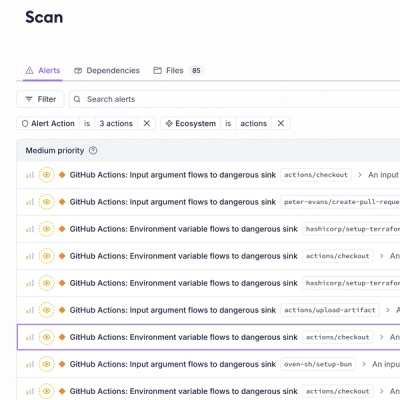
Product
Introducing Socket Firewall Enterprise: Flexible, Configurable Protection for Modern Package Ecosystems
Socket Firewall Enterprise is now available with flexible deployment, configurable policies, and expanded language support.
node-rest-client
Advanced tools
Allows connecting to any API REST and get results as js Object. The client has the following features:
$ npm install node-rest-client
Client has 2 ways to call a REST service: direct or using registered methods
var Client = require('node-rest-client').Client;
client = new Client();
// direct way
client.get("http://remote.site/rest/xml/method", function(data, response){
// parsed response body as js object
console.log(data);
// raw response
console.log(response);
});
// registering remote methods
client.registerMethod("jsonMethod", "http://remote.site/rest/json/method", "GET");
client.methods.jsonMethod(function(data,response){
// parsed response body as js object
console.log(data);
// raw response
console.log(response);
});
POST, PUT or PATCH method invocation are configured like GET calls with the difference that you have to set "Content-Type" header in args passed to client method invocation:
//Example POST method invocation
var Client = require('node-rest-client').Client;
var client = new Client();
// set content-type header and data as json in args parameter
var args = {
data: { test: "hello" },
headers:{"Content-Type": "application/json"}
};
client.post("http://remote.site/rest/xml/method", args, function(data,response) {
// parsed response body as js object
console.log(data);
// raw response
console.log(response);
});
// registering remote methods
client.registerMethod("postMethod", "http://remote.site/rest/json/method", "POST");
client.methods.postMethod(args, function(data,response){
// parsed response body as js object
console.log(data);
// raw response
console.log(response);
});
If no "Content-Type" header is set as client arg POST,PUT and PATCH methods will not work properly.
You can pass diferents args to registered methods, simplifying reuse: path replace parameters, query parameters, custom headers
var Client = require('node-rest-client').Client;
// direct way
client = new Client();
args ={
data:{test:"hello"}, // data passed to REST method (only useful in POST, PUT or PATCH methods)
path:{"id":120}, // path substitution var
parameters:{arg1:"hello",arg2:"world"}, // query parameter substitution vars
headers:{"test-header":"client-api"} // request headers
};
client.get("http://remote.site/rest/json/${id}/method?arg1=hello&arg2=world", args,
function(data, response){
// parsed response body as js object
console.log(data);
// raw response
console.log(response);
});
// registering remote methods
client.registerMethod("jsonMethod", "http://remote.site/rest/json/${id}/method", "GET");
/* this would construct the following URL before invocation
*
* http://remote.site/rest/json/120/method?arg1=hello&arg2=world
*
*/
client.methods.jsonMethod(args,function(data,response){
// parsed response body as js object
console.log(data);
// raw response
console.log(response);
});
You can even use path placeholders in query string in direct connection:
var Client = require('node-rest-client').Client;
// direct way
client = new Client();
args ={
path:{"id":120,"arg1":"hello","arg2":"world"},
parameters:{arg1:"hello",arg2:"world"},
headers:{"test-header":"client-api"}
};
client.get("http://remote.site/rest/json/${id}/method?arg1=${arg1}&arg2=${arg2}", args,
function(data, response){
// parsed response body as js object
console.log(data);
// raw response
console.log(response);
});
To send data to remote site using POST or PUT methods, just add a data attribute to args object:
var Client = require('node-rest-client').Client;
// direct way
client = new Client();
args ={
path:{"id":120},
parameters:{arg1:"hello",arg2:"world"},
headers:{"test-header":"client-api"},
data:"<xml><arg1>hello</arg1><arg2>world</arg2></xml>"
};
client.post("http://remote.site/rest/xml/${id}/method?arg1=hello&arg2=world", args, function(data, response){
// parsed response body as js object
console.log(data);
// raw response
console.log(response);
});
// registering remote methods
client.registerMethod("xmlMethod", "http://remote.site/rest/xml/${id}/method", "POST");
client.methods.xmlMethod(args,function(data,response){
// parsed response body as js object
console.log(data);
// raw response
console.log(response);
});
// posted data can be js object
args_js ={
path:{"id":120},
parameters:{arg1:"hello",arg2:"world"},
headers:{"test-header":"client-api"},
data:{"arg1":"hello","arg2":123}
};
client.methods.xmlMethod(args_js,function(data,response){
// parsed response body as js object
console.log(data);
// raw response
console.log(response);
});
Just pass proxy configuration as option to client.
var Client = require('node-rest-client').Client;
// configure proxy
var options_proxy={
proxy:{
host:"proxy.foo.com",
port:8080,
user:"proxyuser",
password:"123",
tunnel:true
}
},
client = new Client(options_proxy);
client has 2 ways to connect to target site through a proxy server: tunnel or direct request, the first one is the default option so if you want to use direct request you must set tunnel off.
var Client = require('node-rest-client').Client;
// configure proxy
var options_proxy={
proxy:{
host:"proxy.foo.com",
port:8080,
user:"proxyuser",
password:"123",
tunnel:false // use direct request to proxy
}
},
client = new Client(options_proxy);
Just pass username and password as option to client. Every request done with the client will pass username and password as basic authorization header.
var Client = require('node-rest-client').Client;
// configure basic http auth for every request
var options_auth={user:"admin",password:"123"};
client = new Client(options_auth);
You can pass the following args when creating a new client:
var options ={
// proxy configuration
proxy:{
host:"proxy.foo.com", // proxy host
port:8080, // proxy port
user:"ellen", // proxy username if required
password:"ripley" // proxy pass if required
},
// aditional connection options passed to node http.request y https.request methods
// (ie: options to connect to IIS with SSL)
connection:{
secureOptions: constants.SSL_OP_NO_TLSv1_2,
ciphers:'ECDHE-RSA-AES256-SHA:AES256-SHA:RC4-SHA:RC4:HIGH:!MD5:!aNULL:!EDH:!AESGCM',
honorCipherOrder: true
},
// customize mime types for json or xml connections
mimetypes:{
json:["application/json","application/json;charset=utf-8"],
xml:["application/xml","application/xml;charset=utf-8"]
},
user:"admin", // basic http auth username if required
password:"123" // basic http auth password if required
};
Each REST method invocation returns a request object with specific request options and error handler.
var Client = require('node-rest-client').Client;
client = new Client();
// direct way
var req1 = client.get("http://remote.site/rest/xml/method", function(data, response){
// parsed response body as js object
console.log(data);
// raw response
console.log(response);
});
// view req1 options
console.log(req1.options);
// registering remote methods
client.registerMethod("jsonMethod", "http://remote.site/rest/json/method", "GET");
var req2=client.methods.jsonMethod(function(data,response){
// parsed response body as js object
console.log(data);
// raw response
console.log(response);
});
// handling specific req2 errors
req2.on('error',function(err){
console.log('something went wrong on req2!!', err.request.options);
});
Now you can handle error events in two places: on client or on each request.
client = new Client(options_auth);
// handling request error events
client.get("http://remote.site/rest/xml/method", function(data, response){
// parsed response body as js object
console.log(data);
// raw response
console.log(response);
}).on('error',function(err){
console.log('something went wrong on the request', err.request.options);
});
// handling client error events
client.on('error',function(err){
console.error('Something went wrong on the client', err);
});
FAQs
node API REST client
We found that node-rest-client demonstrated a not healthy version release cadence and project activity because the last version was released a year ago. It has 1 open source maintainer collaborating on the project.
Did you know?

Socket for GitHub automatically highlights issues in each pull request and monitors the health of all your open source dependencies. Discover the contents of your packages and block harmful activity before you install or update your dependencies.

Product
Socket Firewall Enterprise is now available with flexible deployment, configurable policies, and expanded language support.

Security News
Open source dashboard CNAPulse tracks CVE Numbering Authorities’ publishing activity, highlighting trends and transparency across the CVE ecosystem.

Product
Detect malware, unsafe data flows, and license issues in GitHub Actions with Socket’s new workflow scanning support.